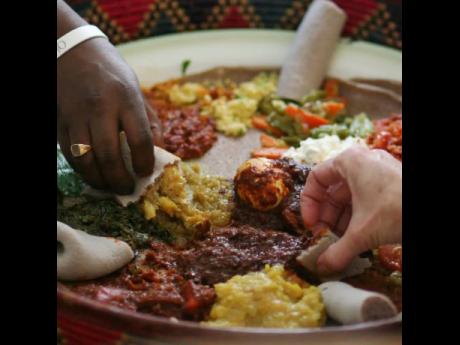Café Africa gives taste of Ethiopia
Ethiopian food is distinctive and delicious, befitting a remarkable country with a cultural heritage that stands out from the rest of Africa. With the Ethiopian Prince Ermias Sahle Selassie, the grandson of Emperor Haile Selassie, slated to arrive in Jamaica today for a week of official engagements, Food decided to explore Ethiopian cuisine
According to Steven Golding, proprietor and executive chef at Café Africa, Ethiopian food reflects on the local heritage and the deep-rooted history and culture of the country that is famously known as the Horn of Africa.
Ethiopia is the 10th largest country in Africa, bordering Somalia, Djibouti, Kenya, and Eritrea.
“Eating Ethiopian-style means rethinking many assumptions you might have about dinnertime. For most of us this means starting with eschewing cutlery and being ready to get messy fingers,” Golding said.
“That’s because the foundation of the vast majority of Ethiopian meals is injera, a giant grey spongey pancake-like bread, upon whose strangely rubbery surface are served a vast array of foods, ranging from multicoloured mounds of spicy stews to vegetable curries to cubes of raw meat,” he added.
All this can take some getting used to. Tourists have been known to mistake injera for the tablecloth or kitchen flannel. Also, the bread’s bitter, slightly sour taste can put some off. But injera’s subtle taste-enhancing power lies in how it contrasts beautifully with, as well as tempers, the fiery sauces it accompanies.
“Ethiopians, like Indians, aren’t shy of adding spices. One of the most common accompaniments is berbere, an Ethiopian spice mix containing up to 16 constituent elements including chili powder, fenugreek, ginger, garlic, cardamom, and cinnamon,” Golding said.
Another bonus of eating Ethiopian is that injera is made from tef – the world’s smallest grain – which Ethiopians have grown and obsessed about for ages. In America and Europe, it is increasingly viewed as a “super grain,” up there with quinoa and spelt, being high in protein and calcium, plus it is also gluten-free.
“Most Ethiopian dishes are good for you, tasty and low in fat,” says Golding.
The result of all of the above will have your taste buds doing somersaults while also being good for you. Most Ethiopian dishes are nutrient-dense and low in fat.
Beyond the endless dishes on offer, it is essential to try Ethiopian coffee after a meal. Ethiopia is reportedly the birthplace of quality Arabica coffee, and its coffees are widely praised as some of the best in the world.
The Ethiopian dining experience is influenced by the term gursha. In Ethiopian culture, gursha means feeding one another and sharing the same plate and the same bread.
POPULAR DISHES:
Doro Wot
Doro Wot is Ethiopia’s version of curry and the ubiquitous companion injera. While beef and goat are often used with wot, chicken – doro in Amharic – reigns as the wot champion.
Doro Wot is made with chicken drumsticks or wings cooked and served in a hot sauce of butter, onion, chilli, cardamom, and berbere. In this stew incongruously bobs a hard-boiled egg. It proves a delicious accompaniment – typically offered to a guest as a sign of respect.
For Ethiopians, Doro Wot is the go-to meal of celebration during national and religious festivals (the day before, women can be seen everywhere carrying upside-down clucking chickens by their feet).
Awaze Tibs
Awaze tibs, also known as Ethiopian beef tibs, is a popular East African dish of beef cooked with various ingredients that combine to create a fragrant, delicious dish. In Ethiopia, tibs refer to a dish with cubed or sliced beef or lamb.
Awaze sauce is a spicy sauce or paste made using Ethiopian ethnic spices. When cooked together, you have a mind-blowing dish you won’t forget in a hurry.
Asa
Eating fish – asa – in Ethiopia is quite an experience. Typically, a fish such as Nile perch is fried and served entirely whole, the gaping mouth of jagged little teeth looking like you have a Piranha on your plate.
As ever, it is eaten by hand with either bread or injera, accompanied by a fiery sauce to dip into. Bar a few bones, Ethiopians eat every bit, and justifiably so – the grilled fins are particularly tasty.
Asa tibs are chunks of fish marinated in berbere spice and lime juice and then fried in sesame oil, olive oil, and paprika, with grated garlic and ginger added. It is a good option if you don’t want the hassle of picking out bones or having to contemplate the fish’s angry-looking face.
Authentic Ethiopian dishes are available in Jamaica at Café Africa, the first truly Pan-African Restaurant in the Caribbean with menu offerings from over 25 countries on the continent of Africa. Cafe Africa is located at 2 Trafalgar Road in New Kingston.



